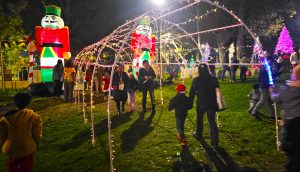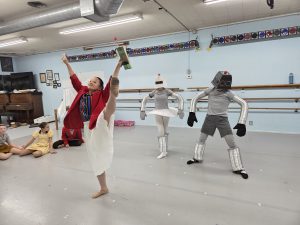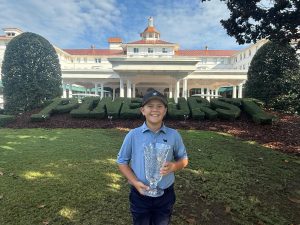On Saturday October 22 from 11 am to 3 pm, Santa Clara University invites the community to celebrate the unveiling of a new “Arts District” beginning with the new Edward M. Dowd Art and Art History building. The festivities include highlights from the humanities: Music, Theatre, Studio Art, Dance, Art History, Film, Literary Arts, de Saisset Museum, and SCU Presents.
Art aficionados will particularly appreciate the new display space in the Art and Art History Building, a significant upgrade from the previous campus gallery. One of the artists, of course, whose works are on display is that of long-time faculty member Senior Lecturer Francisco “Pancho” Jimenez.
But, for Jimenez, there’s more to celebrate this Fall than the new artistic hub on campus. His solo exhibition “Excavations and Interpretations” at the Triton Museum of Art (closing on October 30), has been hugely successful. Three of his pieces sold just at the opening artist reception and will now be featured in the permanent collections at the Crocker Art Museum, the Autry Museum of the American West, and the Triton, a feat head curator Preston Metcalf has not seen in the last thirty-five years.
The news is especially welcome as Jimenez has been reinventing his work due to a surgery on his right arm to repair several decades’ worth of damage. (He previously carved elaborate, large-scale clay creations.) Jimenez reflected, “I woke up from my surgery and almost immediately I had to ask myself, ‘What do I do now? Why am I doing it [my art]? What am I trying to say with it?” For Jimenez, clay is an ancient art form and an authentic, honest way to explore his passion for Pre Colombian and Mesoamerican art. Clay is also a way of capturing the past to reflect on the present and future.
As Jimenez recovered, he became interested in plaster molds for clay. The molds – often free on Craigslist or Ebay – reflected their time periods. The molds from the late 60s to early 70s were utilitarian objects while the molds from the late 70s to early 90s were often commercial, hyper-realistic tchotchkes like the Smurfs or even E.T. “All these forms caused me to reminisce,” Jimenez explained, “they felt familiar in a way, they sparked a meaning, an experience, a sense of the past, and of dreams.” In melting and combining these forms, Jimenez felt that while he was using a new language or vocabulary in the clay, the simple shapes in which they were embedded reflected his original passion for ancient art.
Each of the series in the Triton exhibition reflect how Jimenez embeds these shapes into the figures and faces of his work to reflect the experiences of his often imagined subjects. Viewers will likely be most moved by the “Weapons” series. Jimenez revealed, “I made this collection while listening to NPR and the news – there was so much talk of Syria, civil wars, shootings. So, I wondered: how can the people involved be more embedded in the conversation of these events?” The result are pieces like “Children” and “Men” – two clay handguns embedded with molds directly related to those Jimenez sees as the most common victims of violence: young men and innocent bystanders, especially children.
For now, Jimenez is “following the work” as he explores the continued use of these molds. Happily, the new space at SCU will enhance his practice. “Yes, it’s an aesthetically beautiful space, but it’s also more functionally conducive. […] All the department artists will be working when we’re there – inevitably, it will produce an exchange. There’s a real sense of place when the two departments [of Art and Art History] are together,” Jimenez said. “The new gallery space will also help raise our profile on campus, make it more of a destination.”
Jimenez also hopes that students recognize the value and place of artistic expression in their lives. “I tell students that the arts are a way to think creatively – we tap into critical thinking and give them the skills to look at problems in a new manner. We can then understand how the world communicates – especially visually.”
Those interested in attending the SCU celebration can RSVP here: https://www.scu.edu/cas/dowd/











0 comments